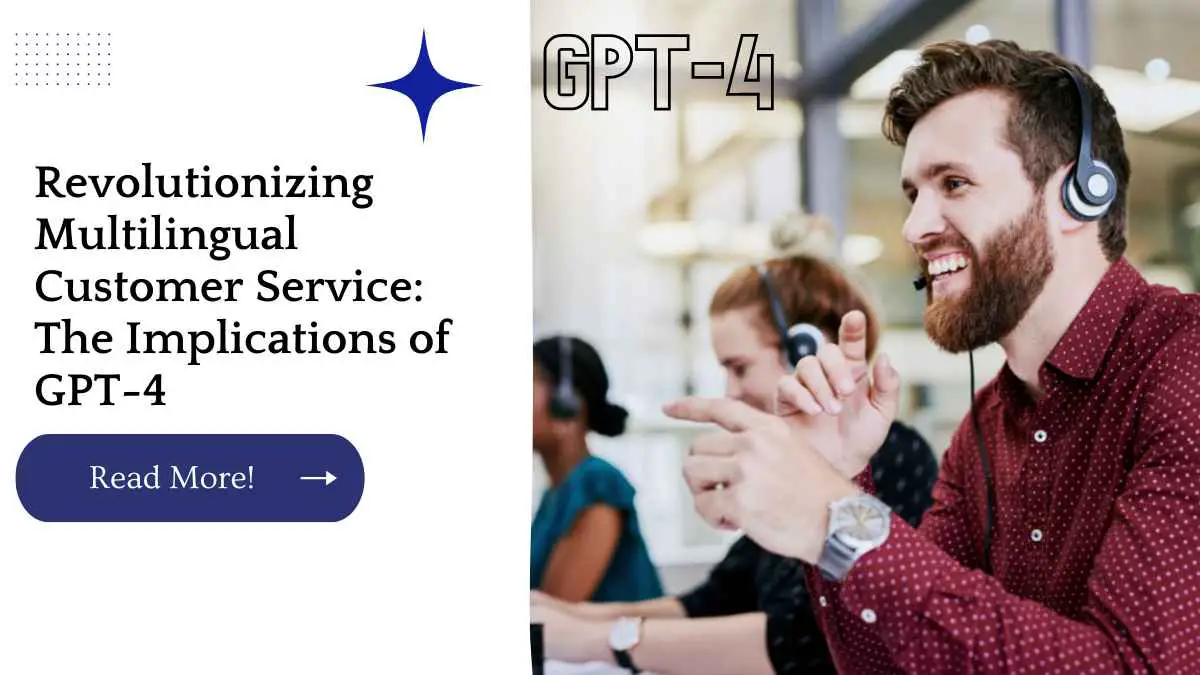The world is becoming more connected, and businesses are expanding globally. With this expansion comes a need for multilingual customer service. However, this can be challenging and expensive for companies.
GPT-4, a new multimodal model from Microsoft-OpenAI, could change the game entirely by providing businesses with the ability to receive questions in one language and answer in another. This technology could enhance the customer experience, reduce costs, and improve brand image. Let’s explore the implications of GPT-4 on multilingual customer service in more detail.
| Takeaways |
|---|
| GPT-4 is the latest natural language processing tool that has the potential to revolutionize customer service, e-commerce, healthcare, education, media and entertainment, social media, and international business. |
| GPT-4’s multimodal capabilities can enhance data analysis, decision-making, personalization, and user experience. |
| GPT-4’s multilingual and multi-modal models can improve learning, diagnosis, and treatment in healthcare, as well as breaking language barriers in international business. |
| GPT-4 can have a significant impact on language learning and translation services, as well as elevating customer service. |
| GPT-4 is set to be released in March 2023 and is expected to be a significant leap in AI language generation. |
Improved Customer Experience
GPT-4’s ability to handle multiple languages means that businesses can provide more accurate and precise answers to customer inquiries, regardless of the language they use. This will significantly improve customer experience and satisfaction, ultimately leading to increased loyalty and retention. Customers who receive quick and accurate responses are more likely to return to the business for future purchases.
GPT-4’s unparalleled capabilities have set new benchmarks in the field of natural language processing. To learn more about the power of GPT-4, check out our article on unveiling the power of GPT-4.
Cost-Effective Customer Service
Hiring multilingual customer support staff can be expensive, but with GPT-4, businesses can reduce the cost of customer service. They will no longer need to hire agents for each language, as the model can handle different languages. This can be particularly helpful for small and medium-sized enterprises that may not have the resources to hire and maintain a multilingual customer service team.
Faster Response Time
GPT-4’s ability to answer questions instantly means that customer inquiries can be resolved more quickly. This could lead to increased customer satisfaction and help businesses handle more inquiries within a shorter timeframe. Additionally, faster response times can help businesses deal with high volumes of inquiries, particularly during peak seasons.
E-commerce businesses are always looking for new ways to enhance the shopping experience for their customers. With GPT-4’s multimodal AI, personalizing the shopping experience has become easier than ever. Learn more about how GPT-4 can benefit e-commerce in our article on GPT-4 and e-commerce.
Enhanced Accuracy
With the ability to recognize visual and audio modalities, GPT-4 will be better equipped to understand customer inquiries, leading to more accurate responses. This can reduce the need for follow-up inquiries and increase overall efficiency. When customers receive accurate and helpful responses, they are more likely to be satisfied with the service they receive.
Improved Brand Image
Multilingual customer service is an essential factor in creating a positive brand image. GPT-4 can help businesses achieve this by providing accurate and speedy responses in different languages. When customers receive high-quality customer service, they are more likely to view the business in a positive light. This can lead to increased brand loyalty and word-of-mouth marketing.
Social media platforms have become an integral part of our lives, and GPT-4’s capabilities can make them even better. To discover how GPT-4 can enhance user experience on social media platforms, check out our article on GPT-4 and social media.
Better Multilingual Communication
GPT-4’s ability to handle multiple languages means that businesses can communicate more effectively with customers from different parts of the world. This can help businesses to expand globally and reach new markets. Effective communication can help to build trust with customers, leading to increased sales and revenue.
Multimodal Capabilities
GPT-4’s integration of multimodal capabilities means that it can understand not only text but also images, video, and sound. This means that it can provide more comprehensive and accurate responses to customer inquiries. This can improve the customer experience and reduce the need for follow-up inquiries.
GPT-4’s multilingual and multimodal models can revolutionize the way we learn and teach languages. Our article on GPT-4 in education explores how GPT-4 can improve language learning and teaching for both students and educators.
Personalized Customer Service
GPT-4 can be trained to understand and recognize individual customers, allowing businesses to provide personalized customer service. Personalized service can improve customer satisfaction and lead to increased loyalty and retention. This is particularly important in industries such as e-commerce, where personalized service can significantly impact sales.
Data Analytics
GPT-4’s ability to handle multiple modalities means that it can analyze data from various sources, including text, images, video, and sound. This can help businesses to gain insights into customer behavior and preferences, leading to more effective marketing and sales strategies. This can ultimately lead to increased revenue
In today’s global economy, language barriers can be a significant obstacle for businesses. However, with GPT-4’s transformative capabilities, international business can become more accessible and efficient than ever. To learn more about the potential of GPT-4 in international business, check out our article on beyond language barriers.
Potential Challenges
Despite the many benefits of GPT-4 for multilingual customer service, there are potential challenges that businesses need to be aware of. One challenge is ensuring the accuracy and quality of responses, particularly in the early stages of training the model. Another challenge is the potential for errors or misunderstandings due to language nuances and cultural differences. Additionally, businesses may need to invest in training their staff on how to use the technology effectively.
Conclusion:
GPT-4 has the potential to revolutionize multilingual customer service, providing businesses with a cost-effective and efficient solution to a longstanding challenge. The model’s ability to handle multiple languages and modalities can improve customer experience, reduce costs, and improve brand image.
However, businesses need to be aware of the potential challenges and invest in effective training to ensure the technology is used to its full potential. Overall, GPT-4 is an exciting development that has the potential to transform customer service for businesses across the globe.
Further Reading
Chat GPT-4: The AI Language Processing Tool: An insightful article that explores the potential of GPT-4 in natural language processing and its applications in various industries.
Can ChatGPT-4 Elevate Your Customer Service?: A comprehensive guide that delves into the benefits of using GPT-4 in customer service, and how it can revolutionize the way businesses interact with their customers.
The Impact of Chat GPT-4 on Language Learning and Translation Services: A thought-provoking article that discusses the impact of GPT-4 on language learning and translation services and how it can transform the way we learn and communicate.
FAQs
What is GPT-4?
GPT-4 (Generative Pre-trained Transformer 4) is an artificial intelligence language generation model developed by OpenAI. It is capable of generating high-quality text content, making it a powerful tool for various industries and applications.
What makes GPT-4 different from its predecessors?
GPT-4 is expected to have significant improvements in terms of its language generation capabilities, including multilingual and multimodal support, better understanding of context and nuance, and improved accuracy and coherence.
What are the potential applications of GPT-4?
GPT-4 can be used in various industries, such as customer service, e-commerce, healthcare, education, and media and entertainment. It can also be used for language translation, content creation, and more.
What are the benefits of using GPT-4 in customer service?
Using GPT-4 in customer service can improve response time, enhance the quality of responses, reduce operational costs, and provide a personalized experience for customers.
How can GPT-4 impact language learning and translation services?
GPT-4’s multilingual and multimodal support can significantly improve language learning and translation services by providing accurate translations, generating high-quality content, and enhancing the learning experience for students.

Costantine Edward is a digital marketing expert, freelance writer, and entrepreneur who helps people attain financial freedom. I’ve been working in marketing since I was 18 years old and have managed to build a successful career doing what I love.

